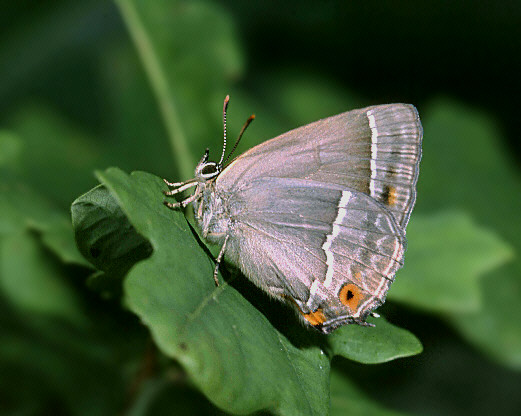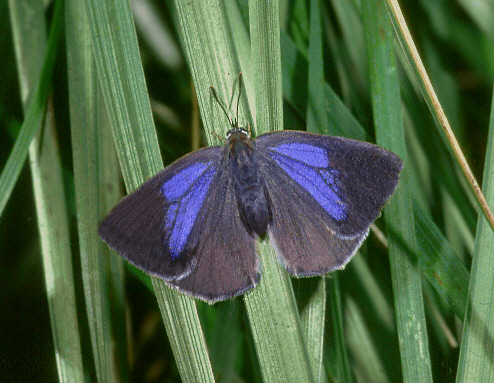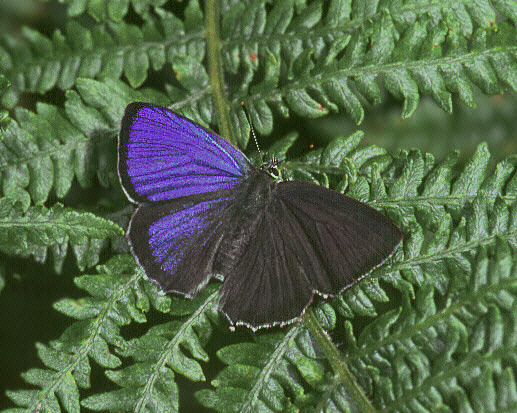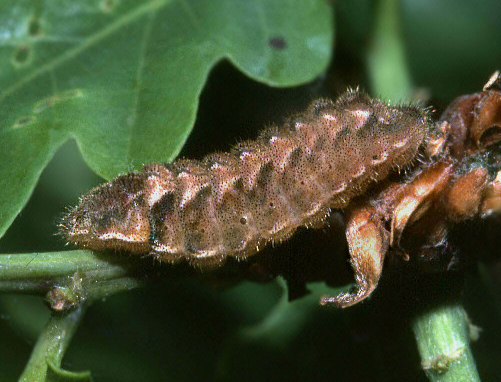Butterflies of
Britain & Europe
Purple Hairstreak
Quercusia quercus
LINNAEUS, 1758
Family - LYCAENIDAE
subfamily -
THECLINAE
Tribe - EUMAEINI
introduction
|
habitats |
lifecycle |
adult behaviour
|
 |
|
Quercusia
quercus, female resting on oak leaf, Hampshire, England |
Introduction
The
Purple Hairstreak is a very widespread species occurring throughout
Europe with the exception of northern Scotland and northern Scandinavia. It's
range extends across the Middle East and temperate Asia as far as the Ural
mountains and Kazakhstan, and it also occurs in Morocco and Algeria.
|
In southern
Britain the Purple Hairstreak is a very common butterfly,
but it's semi-crepuscular nature and habit of spending
most of it's time high in tree tops can create the illusion
that it is scarcer. The true abundance of the butterfly can
be illustrated as follows :
Between
7.00-7.30pm on 2nd July 2008, during a walk
around Whiteley Pastures in Hampshire I counted
173 Purple Hairstreaks in flight around the tops of
oak trees. The mature broad-crowned oaks produced the
highest counts, with between 8 - 12 seen in flight above
each tree, while the smaller and more spindly trees
typically hosted at least 3 or 4 specimens. These figures
only represent butterflies seen in flight, and it can be safely
assumed that for each specimen in flight there must have
been at least another 3 or 4 at rest which escaped detection. During
the limited time available I was only able to look at about
0·5% of the oaks in the wood ( i.e. those along a half-mile
stretch of one particular track ). If my logic is
correct this means the total population of Purple
Hairstreaks at Whiteley Pastures on that particular day was
possibly in excess of 103,800 butterflies ( multiply 173 x 3
to get an estimate of butterflies along the section of track
that I visited, and multiply that figure by 200 to include
the total number of mature oaks in the wood ). |
The
only other European butterfly which could be confused with this species is the
Spanish Hairstreak Laeosopis
roboris, found only in Spain, Portugal
and southern France. It is similar in appearance on the upperside, but the
underside is different, lacking the white "hairstreak" line, and having a
prominent band of orange, white and black submarginal spots.
|
 |
|
Quercusia quercus, female, Surrey, England |
Habitats
In Europe and north
Africa the Purple Hairstreak breeds almost anywhere that oaks grow, even in hot
arid scrubland bordering the Mediterranean.
In Britain it is found
primarily in southern and central England, and throughout Wales. It also occurs
in widely scattered colonies in northern England, in the Scottish Highlands, and
in Ireland.
Heavily wooded areas often have enormous populations of this butterfly. I have
also found a few colonies on isolated stands of oak on heathland
in the New Forest, and in suburban
parks, although these are likely to be relict populations.
|
 |
|
Quercusia quercus, male, Surrey, England |
Lifecycle
Purple Hairstreaks are single
brooded throughout their range, but have a protracted emergence
beginning in late June, and lasting well into August.
They lay their eggs singly, or sometimes in two's and three's, on
the terminal buds and twigs of oaks. The butterflies lay at all
heights on the trees, but young bushy
growth on the crown or the south side of the trees is heavily
favoured.
Following the Great Storm
of October 1987, which felled thousands of trees throughout southern England, I
examined several hundred fallen oaks in Hampshire and West Sussex, and found
that eggs were present on about 95 percent of the English ( pedunculate ) oaks Quercus robur
that I examined. Less than 5 percent of the sessile oaks Q. petraea
held eggs, and none were found on red oak Q. rubra,
turkey oak Q.
cerris,
or holm oak Q. ilex,
although this latter species is certainly used in southern Europe. I also
examined many specimens of sweet chestnut Castanea sativa,
which is given as a foodplant in some early reference works, but found no
evidence of the butterfly using that species.
Eggs were mainly laid on
trees along woodland edges, or bordering forest tracks. Mature oak standards in
hazel or sweet chestnut coppice were also frequently used. Hedgerow oaks are
less commonly used.
The greyish eggs over-winter, and hatch in
late March and early April, when the buds begin to open.
|
 |
|
Quercusia
quercus, fully grown caterpillar feeding on oak |
The
young larvae burrow into the leaf buds to feed, but when older
they spin a thin web of silk around a clump of leaves, resting
within it by day, and emerging at night to feed. The fully grown
larva is plump, with a pair of raised humps on each segment. It rests
at the base of leaf clumps, and frequently has ants in
attendance.
Ants, particularly
Lasius niger, also attend the chrysalis,
which is formed on the ground, and inadvertently protect it from
attack by parasitoids and small predators. The ants usually
cover the chrysalis to hide it, or transport it into their nests
at the base of oak trees.
The adult butterflies emerge in
the early morning, and can sometimes then be seen basking in
groups on the ground or on foliage beneath oaks.
Adult behaviour
The
butterflies are sedentary in nature, and normally only seen when
small groups of them flutter around the tops of oaks in the late
afternoon, presumably indulging in mate location and courtship.
When seen in flight the butterflies appear silvery, like spinning
coins.
During the rest of the day they tend to sit motionless, perched on
foliage in the canopy, resting or feeding on the sugary secretions
of the
oak aphid
Phylloxera quercus, which coat the upper surface of the
oak leaves. This secretion, known as "honey dew" is undoubtedly
the major source of sustenance for adults of both sexes.
I have
occasionally found adults nectaring at hogweed or bramble flowers, or
imbibing mineral-rich moisture from mud or gravel tracks, and have
also found them many times at rest on bracken beneath oaks,
presumably having emerged from the ground, and crawled up the
bracken stems to hang and dry their wings.
On blustery days
Purple Hairstreaks occasionally get blown down from the trees, and can then
be found amongst grasses and low growing plants.
Particular trees
within a wood tend to attract aggregations of adults, which can be
seen flying across forest tracks from other oaks. These assemblies
are probably related to courtship behaviour, as in the case of
Purple Emperors and various other species.
|




